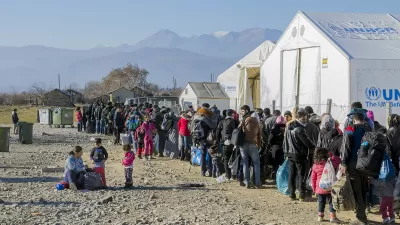To ease the transition from conflict into post-conflict and stability, there is a high need for urban professionals who can artfully balance the demand for security alongside city spaces for healing, argues Mitchell Sutika Sipus.
Today, the world is dotted by low-intensity protracted conflicts, stretching onward by scattered acts of terrorism and insurgency, thus continually threatening civil society and undermining the development of state sponsored institutions. The elongation of war not only drains state resources, but reinforces a cyclical condition of violence, as the population subjected to war must continue to live and die in a constant state of fear and aggression. Unfortunately in these conditions, the triggers of trauma do not go away, making it nearly impossible for local populations to leave behind painful memories and to move forward in their lives.
While contemporary psychology may have individual methods of therapy, tied to the personal history of the victim, there is a clear demand to move forward at an urban scale. While there remains risks, a city consisting of fortified defensive walls and military installations is not a city where one wants to live. Yet at what point do the walls come down? If there is to be a sufficient transition in contemporary warfare from conflict to truly post-conflict, then urban professionals must take it upon themselves to facilitate this change to create infrastructure that meets the immediate demands of security with the long-term demands of healing.
FULL STORY: Demand for Urban Planners to Heal the Trauma of War

Maui's Vacation Rental Debate Turns Ugly
Verbal attacks, misinformation campaigns and fistfights plague a high-stakes debate to convert thousands of vacation rentals into long-term housing.

Planetizen Federal Action Tracker
A weekly monitor of how Trump’s orders and actions are impacting planners and planning in America.

In Urban Planning, AI Prompting Could be the New Design Thinking
Creativity has long been key to great urban design. What if we see AI as our new creative partner?

Massachusetts Budget Helps Close MBTA Budget Gap
The budget signed by Gov. Maura Healey includes $470 million in MBTA funding for the next fiscal year.

Milwaukee Launches Vision Zero Plan
Seven years after the city signed its Complete Streets Policy, the city is doubling down on its efforts to eliminate traffic deaths.

Portland Raises Parking Fees to Pay for Street Maintenance
The city is struggling to bridge a massive budget gap at the Bureau of Transportation, which largely depleted its reserves during the Civd-19 pandemic.
Urban Design for Planners 1: Software Tools
This six-course series explores essential urban design concepts using open source software and equips planners with the tools they need to participate fully in the urban design process.
Planning for Universal Design
Learn the tools for implementing Universal Design in planning regulations.
Gallatin County Department of Planning & Community Development
Heyer Gruel & Associates PA
JM Goldson LLC
City of Camden Redevelopment Agency
City of Astoria
Transportation Research & Education Center (TREC) at Portland State University
Jefferson Parish Government
Camden Redevelopment Agency
City of Claremont



























